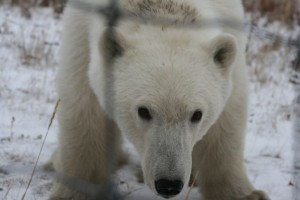A U.S. biodiversity group has petitioned the Commission for Environmental Cooperation, alleging that Canada has failed to enforce its species at risk law by failing to list and protect polar bears as endangered species. Such petitions can lead to a full scale investigation, and possibly an embarrassing report on a country’s failures.
Does Canada obey our own laws on polar bears?
It is well known that sea ice, critical habitat to the polar bear, is shrinking – in large part due to climate change. This is a particular threat to pregnant and nursing females, and their cubs. Of the 20,000 to 25,000 polar bears in the world, approximately 15,500 live in Canada or in territory shared by Canada, in 13 subpopulations.
A petition filed with the Commission for Environmental Cooperation in late November suggests that Canada is not doing enough to protect its polar bears. The U.S. Center for Biological Diversity (CBD) seeks a finding that Canada is not effectively enforcing the Species At Risk Act (SARA) by failing to list and protect the polar bear as an endangered or threatened species.
The SARA established the Committee on the Status of Endangered Wildlife in Canada (COSEWIC), which assesses the status of wildlife species and identifies potential threats to the species, classifying each into the categories of extinct, extirpated (i.e., no longer exists in the wild in Canada), threatened (likely to become an endangered species if nothing is done), of special concern (may become threatened or endangered because of biological characteristics and identified threats), or not currently at risk. Polar bears are classified as species “of special concern”.
Under the SARA, species that are extirpated, endangered or threatened have special protections: for example, it is forbidden to kill, harm or capture them, or to buy, sell or trade them (or any part of them). The Minister (of the Environment, Parks Canada or Fisheries & Oceans, depending on the species) must prepare a recovery strategy for the species, which must address threats to species survival, including loss of habitat, and must identify critical habitat; the strategy must be published on a public registry within specified timelines.
In contrast, there is much less stringent protection for species “of special concern”, where the Minister must only prepare a management plan that includes how the species will be conserved.
COSEWIC reviewed the status of polar bears in Canada in 2008, yet despite noting that “the species cannot persist without seasonal sea ice” the bears remain in the “of special concern” category, where they have been listed since April 1991. COSEWIC noted that there is uncertainty about the overall impact of climate change on polar bears. It projected that bears in 4 (of 13) bear subpopulations are at high risk of declining by 30% or more over 36 years (three bear generations). Seven subpopulations were considered stable or increasing, and COSEWIC could not predict trends for two of the subpopulations.
The CBD alleges that, in its review, COSEWIC failed to consider best available information, as required under the SARA – particularly by ignoring the critical impact that climate change will have on polar bears, an approach that directly conflicts with expert opinions. The CBD challenges COSEWIC’s methodology in that it used the Canadian polar bear population as a whole to evaluate the animal’s status; they should have used units below the species level (called “designatable units”). The CBD concludes that COSEWIC’s assessment of the bear as a species “of special concern” was wrong: it should be considered an endangered species.
The CBD also asserts that the federal Environment Minister failed to meet the deadline to respond to COSEWIC’s recommendation regarding classification of the bears – the government only acknowledged receipt of COSEWIC’s assessment in February 2011, almost three years after the report was completed, instead of within the required 9 months. The government explained that it delayed receipt of the assessment to permit consultation with the Nunavut government and Nunavut Wildlife Management Board. The CBD argues that had the polar bear been listed as endangered when it should have been, a recovery strategy would already be underway.
Is Canada paying attention to what other jurisdictions are doing about polar bears? In 2006, in large part because of the threat from global warming, the animal was moved to the International Union for Conservation of Nature (IUCN) red list of threatened species, a category that corresponds to the threatened category under the SARA.
Similarly, in 2008, the United States listed the animal as a threatened species under the Endangered Species Act of 1973. Endangered species are defined under that Act as those in danger of extinction, and threatened species means any species likely to become an endangered species in the foreseeable future.
Next, the CEC Council will determine whether the submission should be examined further.

